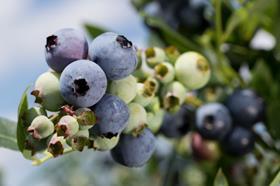
Instead of spraying every two or three weeks, Florida blueberry growers can now use an updated web-based tool to fight the damaging anthracnose fruit rot (AFR) with more precision, thanks to work by University of Florida/Institute of Food and Agricultural Sciences (UF/IFAS) experts.
According to Doug Phillips, UF/IFAS blueberry extension coordinator, blueberries grow throughout much of Florida between December and April, and when their flowers and fruit are developing many farmers use a calendar-based method to spray their plants to protect against AFR.
Under this method, farmers spray fungicide at regular intervals, typically every 14 to 21 days, which over the course of a season can be costly, Phillips said.
UF/IFAS researchers do not know yet how much money farmers might save by using the web tool, with factors including farm size, products used and others all being taken into account.
The weather-based Blueberry Advisory System (BAS), released on 31 January, sends growers alerts that tell them when environmental conditions favour the development of AFR.
“This system allows growers to target their fungicide sprays to those periods when the development of infection is more likely,” Phillips explained. “In many cases, this system will decrease spray applications in a given season, while achieving a comparable level of disease control.”
Growers can also use risk assessments to choose whether to use a less-expensive fungicide when they encounter moderate disease risk, or a more expensive product that may be more effective during high-risk periods, he said.
UF/IFAS tested BAS on nine blueberry farms during the 2018 and 2019 seasons, and results were good. BAS notified growers to spray fungicide when AFR was more likely to develop, and in most cases, they didn’t need to apply the sprays as often, Phillips continued.
Data for the AFR risk models come from the Florida Automated Weather Network (FAWN), which has weather stations throughout the state.
UF/IFAS experts have rated the risks for AFR development as 'low' (less than 15 per cent), 'moderate' (15-50 per cent) or 'high' (greater than 50 per cent).
Growers who sign up for notifications will receive a text message and/or email when the risk is moderate or high, Phillips said.
Rainfall or overhead irrigation can compound the problem by spreading the pathogen to healthy fruit and plants, creating additional opportunities for infection, and the pathogen can also be spread by fruits touching each other and from harvesting machinery and sorting equipment – thus, growers can help control the disease primarily by timely application of fungicides.
“Good practices can also help reduce the risk of developing anthracnose fruit rot,” Phillips added. “They include periodic pruning to open the plant canopy, harvesting frequently to avoid overripe berries, and rapid cooling of fruit following harvest.”



